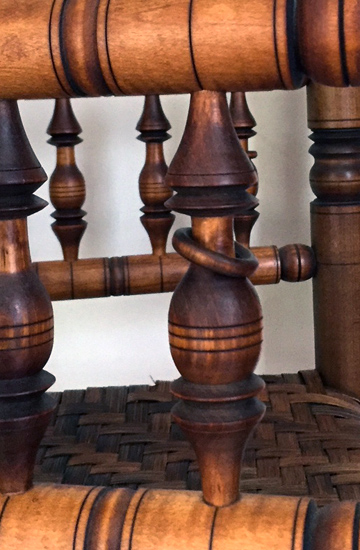My Story
 My interest in building replicas of 17th & 18th century American furniture and architectural components began in 1972 from a professor of humanities at college whose interest and passion in early tools and furniture, and friendship I treasure, and which continues to the present.
My interest in building replicas of 17th & 18th century American furniture and architectural components began in 1972 from a professor of humanities at college whose interest and passion in early tools and furniture, and friendship I treasure, and which continues to the present.
I began gathering and restoring necessary and appropriate tools, studying styles, design and construction methods, visiting museums and historic sites, measuring and drawing, going to sawmills, and working in earnest. My training and education was by application, no classes, no visual aids (not then), and no power equipment- everything hand sawn from 4/4" to 16/4" stock in all woods, from small boxes to chests, cupboards, chairs, tables, beds, and everything else an apprentice would do. This, I continued for eight years and started in business in 1980.
Having grown up in Connecticut the body of my work represents predominantly New England furniture and architectural design from 1620 to the Federal period. I build furniture of every sort and style - simple to elegant, in all woods appropriate, and raised panel walls, shell top corner cupboards (nine in all), wainscoting and mouldings, carved fireplace mantels, stair case balusters newel posts and railings, and doorways.
Throughout these years I have repaired, restored, and conserved an extensive and significant number of pieces of every sort for individuals, collectors, antique dealers and historic institutions including pieces of important historic rarity, as well as consulting on the authentication and purchase of antique furniture.
Since the 1970's I have presented and have been a part of many educational demonstrations and seminars for museums, schools, historical societies and historic sites.
Workmanship
 It is from the design, creativity, understanding and knowledge of the materials and tools, industry and skill level of our Colonial furniture makers that inspired me to emulate their wonderful work. They were fine craftsmen who took English and Continental prototypes and reinterpreted them on a new continent for a "New World".
It is from the design, creativity, understanding and knowledge of the materials and tools, industry and skill level of our Colonial furniture makers that inspired me to emulate their wonderful work. They were fine craftsmen who took English and Continental prototypes and reinterpreted them on a new continent for a "New World".
Presented in these pictures are examples of their designs showing a representative sampling from the 17th & and 18th century using methods of joynery, tools, wood selection, and finishes of the period.
All of this work, past and present show many and varied details: mouldings, fluting and reeding are executed with period wooden planes I've restored, or carved or turned where necessary. All surfaces are finally made smooth by hand planeing or scraping, which leaves a wonderful glistened surface.
The most ornamental and beautiful addition or part to furniture or architecture is carved decoration. All of my carving is accomplished completely by hand. These include: the scalloped shell or fan tops of cupboards, serpentine moulded crowns and fans, shells and feet on high chests, all arched panels on doors and wall paneling, relief carving on boxes, chests, and exterior doorways, spiral carving on finials, candlestands, bed posts, balusters and volutes, and chip carving on spoon racks and boxes and more!
Turning is a major element of my work. My lathe is a mid 18th century post and beam great wheel lathe with 7"x 9" ways and 6"x 16" ends, 8' tall, from Woodbury, Ct. that I purchased in 1972, and thus began my turners life as well. Turning is also a very significant, ornamental and articulated part of furniture and architectural design of the 17th & 18th century and of course from the ancient to the present. Just about every piece of furniture can have a turned part and sometimes all parts! I have made thousands of turnings on this lathe over these years, for all that has, and hasn't been previously spoken of. As an example, I've made over a hundred chairs for just four clients, and for one house restoration in the '80's I turned 185 stair balusters, and there has been a countless number since, and many more before I sleep!
Lastly, my work is a labor of love, a passion, authenticity, a respect and reverence for the history and artistry in wood. It is also and mostly a testimony to all the craftsmen who have provided for us this Treasury of American Design.
-Craig Farrow